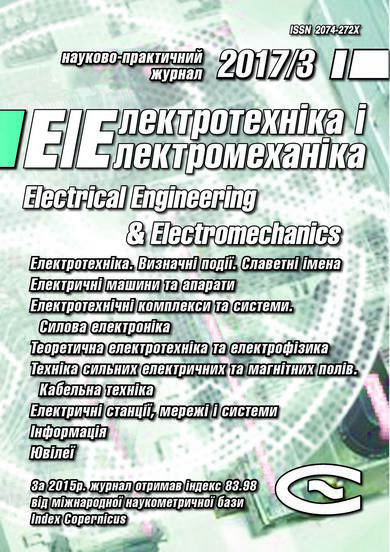A COMPUTER PROGRAM FOR INTERPRETATION OF THE DATA OF VERTICAL ELECTRICAL SOUNDING VEZ-4A
DOI:
https://doi.org/10.20998/2074-272X.2017.3.09Keywords:
vertical electrical sounding, grounding, soil, Wenner installationAbstract
Purpose. Creating a computer program for interpreting the results of vertical sounding the soil in the form of multilayer model most typical for Ukraine. Methodology. The algorithm of the program is constructed on determination the soil structure with the help of the method of point source current, method of analogy and method of equivalent. The option of automatic interpretation based on Hook-Jeeves method. The program is implemented in the programming language Delphi. Results. The computer program «VEZ-4A» has a possibility of the interactive and automatic interpretation sounding results in the multi-layered geoelectrical model. Originality. In first time the computer program for analyzing and interpreting results of the soil sounding by Wenner configuration was created on the base of the analytical solution for field of current point source located in four-, three- or two-layer structure. In paper the review is presented and basic functions of our program are analyzed. Practical value. The program «VEZ-4A» is created and adapted for use in the electromagnetic diagnostics of grounding of existing power plants and substations.References
1. Natsional'nyy standart Ukrayiny. SOU 31.2-21677681-19:2009. Viprobuvannya ta kontrol' prystroyiv zazemlennya elektroustanovok. Tipova іnstruktsіya. [National Standard of Ukraine SOU 31.2-21677681-19:2009. Test and control devices, electrical grounding. Standard instruction]. Kyiv, Mіnenergovugіllya Ukrayiny Publ., 2010. 54 p. (Ukr).
2. Koliushko D.G., Rudenko S.S., Koliushko G.M. Analysis of electrophysical characteristics of grounds in the vicinity electrical substation of Ukraine. Electrical engineering & electromechanics, 2015, no.3, pp. 67-72. (Rus). doi: 10.20998/2074-272X.2015.3.10.
3. Shevnin V.A., Kolesnikov W.P. Rating depth VES for the uniform and layered medium. Electronic Journal «GEORazrez», 2011, no.1(8), pp. 1-9. Available at: http://www.georazrez.ru/download/2011/08/Shevnin-Otcenka_glubinnosti_VEZ.pdf (Accessed 10 November 2013). (Rus).
4. Burgsdorf V.V., Yakobs A.I. Zazemlyayushchie ustroystva elektroustanovok [Grounding device of electrical installations]. Moscow, Energoatomizdat Publ., 1987. 400 p. (Rus).
5. Koliushko D.G., Rudenko S.S. Interpretation the results of the vertical electrical sounding as the geoelectrical half space with four layer. Bulletin of NTU «KhPІ», 2015, no.12(1121), pp. 324-329. (Rus).
6. Koliushko G.M., Koliushko D.G., Rudenko S.S. On the problem of increasing computation accuracy for rated parameters of active electrical installation ground grids. Electrical engineering & electromechanics, 2014, no.4, pp. 65-70. (Rus). doi: 10.20998/2074-272X.2014.4.13.
7. Petkov A.A., Koliushko D.G., Link I.Y. Determination of parameters two-layer model of ground on the results for the vertical electric sounding conducted in the vicinity of substation. Electrification and automation of agriculture, 2004, no.2(7),
pp. 3-11. (Ukr).
Downloads
Published
How to Cite
Issue
Section
License
Copyright (c) 2017 D. G. Koliushko, S. S. Rudenko

This work is licensed under a Creative Commons Attribution-NonCommercial 4.0 International License.
Authors who publish with this journal agree to the following terms:
1. Authors retain copyright and grant the journal right of first publication with the work simultaneously licensed under a Creative Commons Attribution License that allows others to share the work with an acknowledgement of the work's authorship and initial publication in this journal.
2. Authors are able to enter into separate, additional contractual arrangements for the non-exclusive distribution of the journal's published version of the work (e.g., post it to an institutional repository or publish it in a book), with an acknowledgement of its initial publication in this journal.
3. Authors are permitted and encouraged to post their work online (e.g., in institutional repositories or on their website) prior to and during the submission process, as it can lead to productive exchanges, as well as earlier and greater citation of published work.





